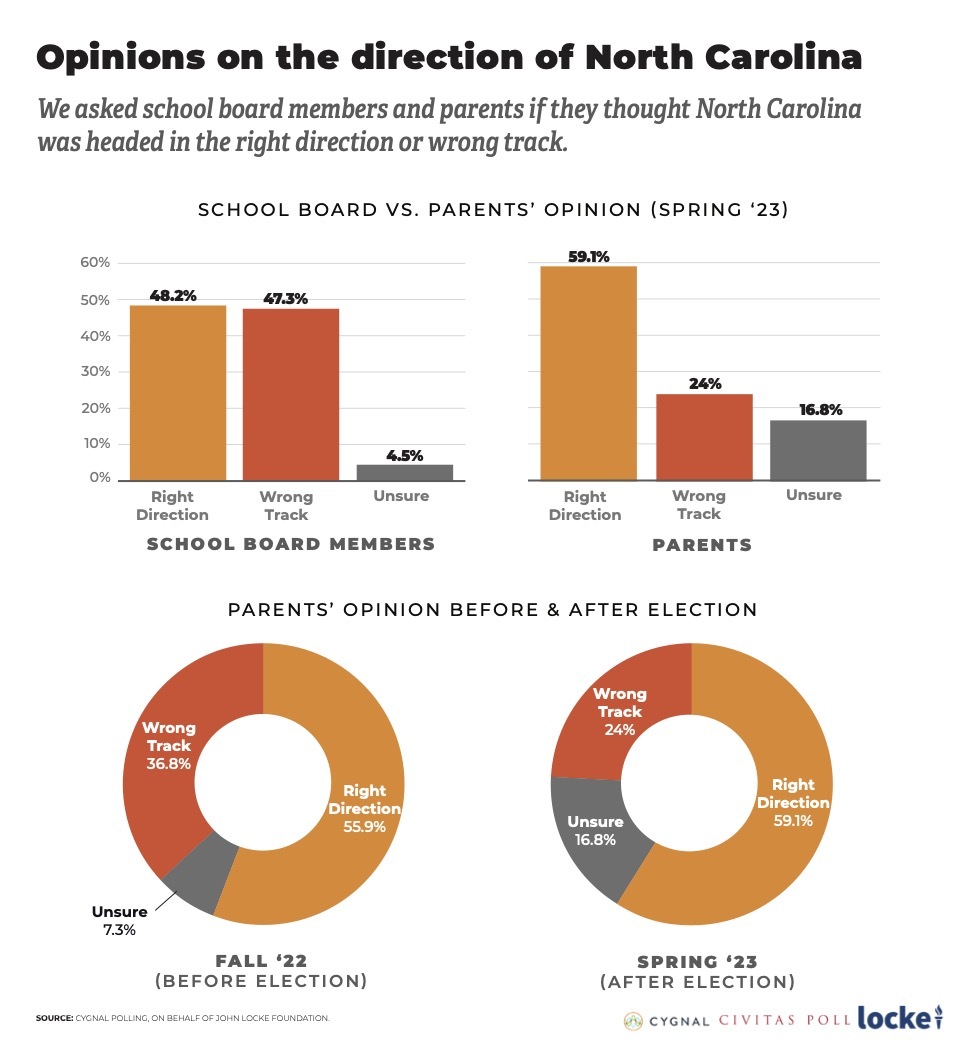The First Amendment Guarantees ALL Freedoms, including a Truthful Press
What We Learned from Polls of Parents and School Board Members
Publisher's Note: This post appears here courtesy of the John Locke Foundation. The author of this post is Dr. Robert Luebke.
Anyone who cares about K-12 education in North Carolina knows the last few years have not brought much to be happy about. A pandemic exposed the education system's inability to deal with disruption. Government policies to close schools or significantly modify instruction stunted the academic, emotional, and social development of students. More recently, contentious battles over Critical Race Theory and gender identity have polarized classrooms and turned parents and school boards against each other.
Last September the John Locke Foundation commissioned polls of parents and school board members to take a snapshot of public opinion and better inform parents and school board members about public sentiment. Specifically, we wanted to identify where opinions of board members and parents converged or diverged and determine if school board members represented the views of the parents who elected them. That concern remained unresolved, however, given that so many school board members refused to answer our survey questions that we were unable to collect meaningful data.
Choosing not to answer is still an answer, and it provides a data point, but how exactly were we to factor it in? In the meantime, we were able to generate four articles from the survey of North Carolina parents. Among the key findings of the Fall 2022 Civitas Parents Poll:
Last fall's poll results certainly reflected a charged and polarized environment. How do parents and school board members feel today about public education in North Carolina? Opinion polls offer one barometer of public sentiment. Another one is state and local elections. Local school board elections are certainly indicative of how the public feels about education.
School Board Elections
Last November elections were held in 83 of 115 school districts in North Carolina. Of those 83 school districts, partisan elections were held in 42 school districts, and nonpartisan elections were held in 41 districts.
After the election, of the 83 districts that had elections, the number of districts controlled by Republican majorities increased from 48 to 53 school districts, while the number of districts controlled by Democrats declined from 33 to 25. Republicans flipped six nonpartisan districts and held on to 47 of 48 school districts that had Republican majorities. Moreover, the number of split-control districts (in which each party has equal representation) increased from two to five. Overall, conservative candidates and pro-parent themes were strong in rural areas, while progressive candidates were strong in cities. School board elections in the suburbs were largely standoffs with small changes on each side but no flipped boards.
The Current Landscape
Several pertinent questions emerge from these developments. Do school board election results signify a shift in public sentiment? Is that sentiment reflected on school boards and in school policy? How do the views of parents and school board members converge or diverge on major issues? How have sentiments changed since last fall?
To answer these questions, the John Locke Foundation commissioned two more polls this spring: one of North Carolina parents and one of local school board members in North Carolina. The poll of North Carolina parents includes responses from over 500 parents and was administered April 25-27. The poll of North Carolina school board members includes responses from 112 members. It was administered from April 25-May 3. For information on poll methodology see the end of this article.
Poll Findings
Results from the school board member poll and parent poll are now available. This article will focus on responses to questions about the direction of North Carolina schools, perceptions about governance, and responses on how schools address controversial issues. Other forthcoming articles will focus on teachers, objectionable materials, and a few other matters.
Selected highlights and observations from the polls follow below.
Would you say education in North Carolina is headed in the right direction or on the wrong track?
Parents are more optimistic about the future of education in North Carolina, while board members are evenly divided
Regarding the question of whether education in North Carolina is heading in the right direction or on the wrong track, parents appear more optimistic than school board members. A full 59 percent of parents said North Carolina was on the right track, up 3 percentage points from 2022 (56 percent). Twenty-four percent of parents thought the state was on the wrong track, down 13 percentage points from 2022. Respondents who were "unsure" increased from 7 percent to 17 percent.
The positive sentiment was bipartisan. Among Republicans, 55 percent said North Carolina was on the right track (29 percent said wrong track). A higher proportion of Democrats (71 percent) said North Carolina is on the right track, with only 17 percent who said wrong track. Independent parents, however, were much more pessimistic and divided: 39 percent selected right track, while 33 percent said wrong track.
School board members were less optimistic and more divided. Less than half (48 percent) of school board members responded that North Carolina was on the right track. Another 47 percent of board members said North Carolina was on the wrong track. Republican board members selected wrong track (47 percent) by a slightly higher margin than right track (44 percent). Democrats chose right track by a larger margin (55 percent to 45 percent wrong track), while Independent board members were evenly split on the question (48 percent for each).

What grade would you assign to a school board to reflect the quality of their work?
School board members gave themselves higher grades than parents did, but grades from parents did improve significantly over 2022
Both polls asked respondents to assign a grade to the work of school boards. Board members awarded themselves higher grades than did the parents. Nearly half (49 percent) of board members awarded school boards with a B grade, and this grading was consistent among Republican and Democratic board members. Nineteen percent awarded A's, and with A and B grades combined, over two-thirds (68 percent) of the grades awarded by school board members were A's and B's. Just over one in five board members (21 percent) gave school boards C grades, nearly 3 percent gave D's, and nearly 3 percent, F's.
Parents' grades of the work being done by school boards were less generous. About one-third (nearly 34 percent) gave B's, but a higher percentage (nearly 24 percent) awarded A's. While 68 percent of school board members gave out A's and B's, only 57 percent of parents did. At the same time, 11 percent of parents handed out D's and F's, compared with only about 6 percent of school board members. Twenty-four percent of parents handed out C grades.
Go Back
- Large percentages of school board members and parents agreed that parents have a legal right to all medical and psychological information about their child
- Board members and parents agreed parents are best suited to determine how and where a child is educated
- Asked to grade the work of school boards, over two-thirds of school board members gave A's and B's, while approximately 58 percent of parents gave out A's and B's
Anyone who cares about K-12 education in North Carolina knows the last few years have not brought much to be happy about. A pandemic exposed the education system's inability to deal with disruption. Government policies to close schools or significantly modify instruction stunted the academic, emotional, and social development of students. More recently, contentious battles over Critical Race Theory and gender identity have polarized classrooms and turned parents and school boards against each other.
Last September the John Locke Foundation commissioned polls of parents and school board members to take a snapshot of public opinion and better inform parents and school board members about public sentiment. Specifically, we wanted to identify where opinions of board members and parents converged or diverged and determine if school board members represented the views of the parents who elected them. That concern remained unresolved, however, given that so many school board members refused to answer our survey questions that we were unable to collect meaningful data.
Choosing not to answer is still an answer, and it provides a data point, but how exactly were we to factor it in? In the meantime, we were able to generate four articles from the survey of North Carolina parents. Among the key findings of the Fall 2022 Civitas Parents Poll:
- 56 percent of respondents thought North Carolina was moving in the right direction on education, while 37 percent of respondents said North Carolina was on the wrong track.
- Approximately 45 percent of parents said the educational system "needs some changes and improvements." Only 10 percent of respondents thought the public schools were "working reasonably well."
- 45 percent of parents said schools spent too much time teaching sexual preference and gender identity.
- Over a third (35 percent) of respondents thought school boards should have less authority over the curriculum.
- Approximately 72 percent of parents said classrooms had become more politicized in the last five years.
Last fall's poll results certainly reflected a charged and polarized environment. How do parents and school board members feel today about public education in North Carolina? Opinion polls offer one barometer of public sentiment. Another one is state and local elections. Local school board elections are certainly indicative of how the public feels about education.
School Board Elections
Last November elections were held in 83 of 115 school districts in North Carolina. Of those 83 school districts, partisan elections were held in 42 school districts, and nonpartisan elections were held in 41 districts.
After the election, of the 83 districts that had elections, the number of districts controlled by Republican majorities increased from 48 to 53 school districts, while the number of districts controlled by Democrats declined from 33 to 25. Republicans flipped six nonpartisan districts and held on to 47 of 48 school districts that had Republican majorities. Moreover, the number of split-control districts (in which each party has equal representation) increased from two to five. Overall, conservative candidates and pro-parent themes were strong in rural areas, while progressive candidates were strong in cities. School board elections in the suburbs were largely standoffs with small changes on each side but no flipped boards.
The Current Landscape
Several pertinent questions emerge from these developments. Do school board election results signify a shift in public sentiment? Is that sentiment reflected on school boards and in school policy? How do the views of parents and school board members converge or diverge on major issues? How have sentiments changed since last fall?
To answer these questions, the John Locke Foundation commissioned two more polls this spring: one of North Carolina parents and one of local school board members in North Carolina. The poll of North Carolina parents includes responses from over 500 parents and was administered April 25-27. The poll of North Carolina school board members includes responses from 112 members. It was administered from April 25-May 3. For information on poll methodology see the end of this article.
Poll Findings
Results from the school board member poll and parent poll are now available. This article will focus on responses to questions about the direction of North Carolina schools, perceptions about governance, and responses on how schools address controversial issues. Other forthcoming articles will focus on teachers, objectionable materials, and a few other matters.
Selected highlights and observations from the polls follow below.
Would you say education in North Carolina is headed in the right direction or on the wrong track?
Parents are more optimistic about the future of education in North Carolina, while board members are evenly divided
Regarding the question of whether education in North Carolina is heading in the right direction or on the wrong track, parents appear more optimistic than school board members. A full 59 percent of parents said North Carolina was on the right track, up 3 percentage points from 2022 (56 percent). Twenty-four percent of parents thought the state was on the wrong track, down 13 percentage points from 2022. Respondents who were "unsure" increased from 7 percent to 17 percent.
The positive sentiment was bipartisan. Among Republicans, 55 percent said North Carolina was on the right track (29 percent said wrong track). A higher proportion of Democrats (71 percent) said North Carolina is on the right track, with only 17 percent who said wrong track. Independent parents, however, were much more pessimistic and divided: 39 percent selected right track, while 33 percent said wrong track.
School board members were less optimistic and more divided. Less than half (48 percent) of school board members responded that North Carolina was on the right track. Another 47 percent of board members said North Carolina was on the wrong track. Republican board members selected wrong track (47 percent) by a slightly higher margin than right track (44 percent). Democrats chose right track by a larger margin (55 percent to 45 percent wrong track), while Independent board members were evenly split on the question (48 percent for each).

What grade would you assign to a school board to reflect the quality of their work?
School board members gave themselves higher grades than parents did, but grades from parents did improve significantly over 2022
Both polls asked respondents to assign a grade to the work of school boards. Board members awarded themselves higher grades than did the parents. Nearly half (49 percent) of board members awarded school boards with a B grade, and this grading was consistent among Republican and Democratic board members. Nineteen percent awarded A's, and with A and B grades combined, over two-thirds (68 percent) of the grades awarded by school board members were A's and B's. Just over one in five board members (21 percent) gave school boards C grades, nearly 3 percent gave D's, and nearly 3 percent, F's.
Parents' grades of the work being done by school boards were less generous. About one-third (nearly 34 percent) gave B's, but a higher percentage (nearly 24 percent) awarded A's. While 68 percent of school board members gave out A's and B's, only 57 percent of parents did. At the same time, 11 percent of parents handed out D's and F's, compared with only about 6 percent of school board members. Twenty-four percent of parents handed out C grades.

























